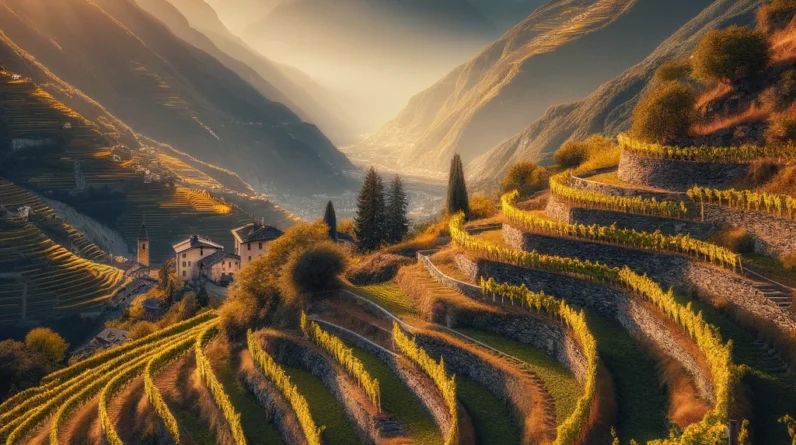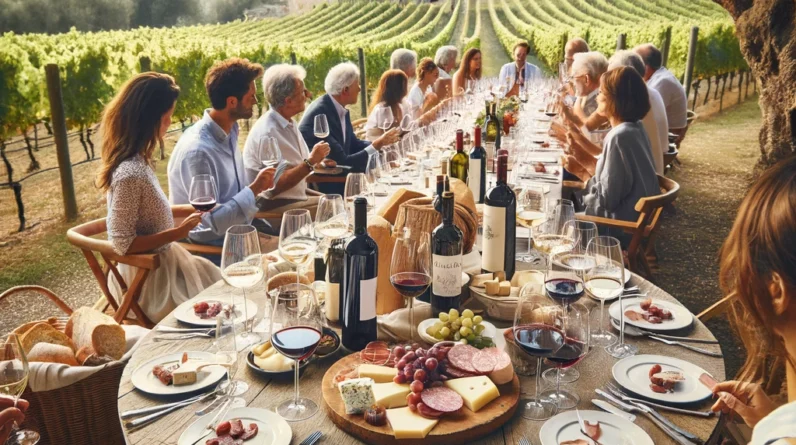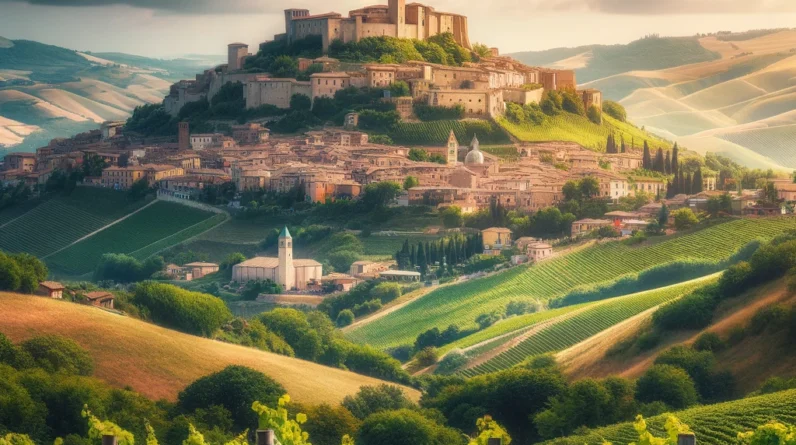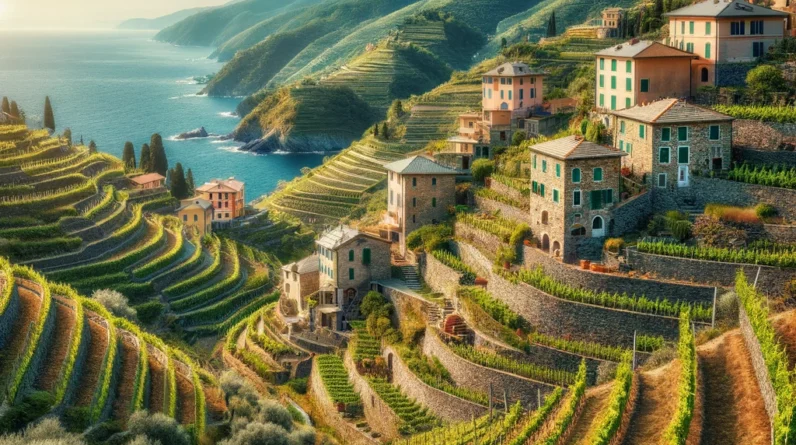
Exploring the Hidden Treasures of Liguria: A Journey Through Its Vineyards and Wines
Nestled between the azure waters of the Mediterranean and the rugged peaks of the Apennines lies Liguria, Italy’s hidden gem.
Known for its picturesque coastal towns and lush landscapes, this region is also home to a lesser-known, yet equally enchanting world of wines and vineyards.
Liguria’s wine scene, though overshadowed by its more famous Italian counterparts, is a treasure trove of unique flavors, rich history, and breathtaking beauty.
In this exploration, we’ll embark on a delightful journey through the heart of Liguria’s wine country.
From the crisp, aromatic whites to the light and fruity reds, each glass tells a story of tradition, terroir, and passion.
Join us as we uncover the secrets of Ligurian wines, visit the region’s most renowned vineyards, and delve into the cultural tapestry that makes these wines truly special.
Whether you’re a seasoned wine connoisseur or a curious traveler, prepare to be captivated by the charm and elegance of Liguria’s viticultural offerings.
Let’s raise a glass to this enchanting journey through one of Italy’s most alluring wine regions!
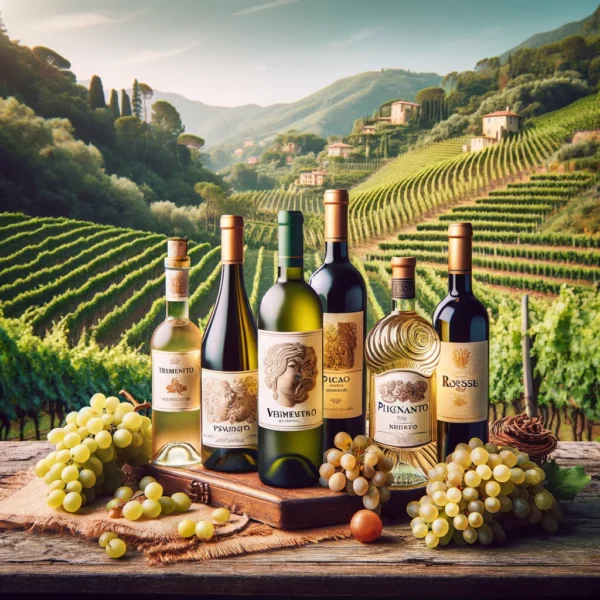
The General Overview of Liguria Wine Region
Nestled in the northwestern corner of Italy, Liguria is a slender crescent hugging the Ligurian Sea, known for its rugged beauty, ancient traditions, and, of course, its distinctive wines.
This region, often overshadowed by its more famous Italian neighbors, holds a unique charm in the world of viticulture.
Cultural and Historical Context
Wine production in Liguria is steeped in history.
Dating back to the Roman times and influenced by various cultures over the centuries, Ligurian wines are a testament to the region’s rich heritage.
This history is reflected in the traditional wine-making methods still used today, preserving the authenticity and character of Ligurian wines.
Terroir: A Coastal Harmony
Liguria’s terroir is a harmonious blend of mountainous terrain and maritime influence.
The region stretches along the Mediterranean coast, bordered by the Alps and Apennines.
This unique positioning creates a series of microclimates that are key to the diverse flavor profiles of Ligurian wines.
Vineyards are often perched on steep slopes, making viticulture here a labor of love and tradition.
Grapes: A Palette of Diversity
The region’s wine portfolio is dominated by two primary grape varieties: Vermentino and Pigato for white wines, and Rossese and Sangiovese for reds.
Vermentino, with its bright, refreshing profile, is a coastal favorite, while Pigato offers more complexity with herbal and nutty notes.
Rossese, a red grape, produces light-bodied wines that are a testament to the subtlety Liguria can achieve, and Sangiovese, although more widespread in Italy, finds its unique expression here.
| Grape | Flavor Profile | Usage in Liguria | Type |
|---|---|---|---|
| Vermentino
| Crisp, floral, citrusy | Widespread in coastal areas | White |
| Pigato
| Intense, herbal, almond notes | Riviera Ligure di Ponente | White |
| Rossese
| Light, aromatic, fruity | Rossese di Dolceacqua | Red |
| Albarola
| Dry, delicate, slightly acidic | Cinque Terre and Levanto | White |
| Bosco
| Full-bodied, high acidity | Cinque Terre | White |
| Sangiovese
| Fruity, herbal, earthy | Colline Savonesi | Red |
Soils: The Foundation of Flavor
Liguria’s soils contribute significantly to the character of its wines.
The region boasts a diverse geological makeup, ranging from sandy and gravelly coastal plains to the rocky, limestone-rich soils of the hills.
These varied soils, along with the steep terrains, ensure excellent drainage, a critical factor in grape cultivation.
This mineral-rich soil composition imparts a distinct minerality to the wines, a hallmark of Ligurian terroir.
Climate: A Maritime Influence
The climate in Liguria is predominantly Mediterranean, characterized by mild winters and warm, dry summers.
The region benefits from the moderating influence of the sea, which helps maintain a relatively stable temperature throughout the year.
This climate is ideal for slow, even ripening of grapes, allowing them to develop a full range of flavors while retaining essential acidity.
The sea breezes also play a crucial role in vine health, providing natural ventilation which helps prevent the development of vine diseases.
The Liguria wine region, with its picturesque landscapes and ancient vineyard terraces, is a testament to the harmonious interaction between nature and human craftsmanship.
Its wines, though not as widely known as some other Italian regions, are hidden gems that reflect the unique character of their terroir.
The combination of diverse soils, a favorable climate, and distinctive grape varieties make Liguria a fascinating and rewarding destination for any wine enthusiast.
This region’s wines are not just beverages; they are stories told in a glass, echoing the history, culture, and spirit of this enchanting Italian coastal region.
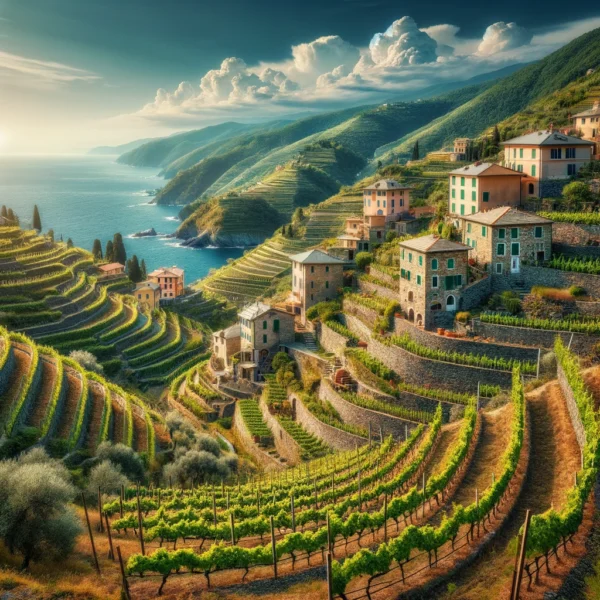
Notable Vineyards and Wineries
Liguria boasts several renowned vineyards and wineries.
Wineries like Cantine Lunae Bosoni and Poggio dei Gorleri are known for their exceptional Vermentino.
The Cinque Terre region, though more challenging for viticulture due to its steep terraces, produces exquisite Sciacchetrà, a sweet dessert wine.
Each vineyard here has its unique story, often intertwined with Ligurian culture and history.
| Vineyard | Designation | Primary Grapes |
|---|---|---|
| Cantine Lunae Bosoni
| DOC Colli di Luni | Vermentino, Albarola |
| Poggio dei Gorleri
| DOC Riviera Ligure di Ponente | Vermentino, Pigato |
| Cinque Terre Region
| DOC Cinque Terre | Bosco, Albarola, Vermentino |
| Vigneti Vecchio
| IGT Colline Savonesi | Sangiovese, Vermentino |
| Terre Bianche
| DOC Rossese di Dolceacqua | Rossese |
Winemaking in Liguria
Winemaking in Liguria, like in many Italian wine regions, is a blend of tradition and modern innovation.
Terraced Vineyards
Due to the region’s steep and hilly terrain, many vineyards are terraced.
This ancient technique maximizes land use and exposure to the sun while aiding in soil retention and water management.
Hand Harvesting
The terrain often requires grape harvesting to be done by hand.
This labor-intensive process allows for selective picking, ensuring that only the best grapes are chosen for winemaking.
Limited Use of Chemicals
Many Ligurian winemakers practice organic or biodynamic viticulture, limiting the use of chemicals in both the vineyard and the winemaking process.
This approach respects the natural environment and tends to produce grapes that more authentically express their terroir.
Controlled Fermentation
Modern winemakers in Liguria often use temperature-controlled fermentation to preserve the aromatic qualities of their wines, especially important for white wines like Vermentino and Pigato.
Indigenous Yeasts
Some winemakers prefer using indigenous yeasts (naturally occurring on the grapes and in the cellar) for fermentation.
This can add complexity and a unique sense of place to the wines.
Aging Techniques
The aging process varies depending on the wine.
While many white wines are released relatively young to maintain their freshness, some, like certain high-quality Vermentinos, may benefit from barrel aging.
Red wines like Rossese can be aged in a variety of vessels, ranging from traditional oak barrels to modern stainless steel tanks, influencing the flavor and texture of the final product.
Minimal Intervention Philosophy
A growing number of winemakers in Liguria embrace a ‘minimal intervention’ philosophy.
This means less manipulation during winemaking, such as reduced filtering and fining, to create wines that are more natural and expressive of their origin.
Experimentation and Innovation
While respecting tradition, Ligurian winemakers are also open to experimentation, whether it’s in blending different varieties, trying new fermentation techniques, or adopting sustainable practices in both the vineyard and the cellar.
In summary, Ligurian winemaking is characterized by a respect for tradition, a deep connection to the land, and a willingness to embrace modern techniques and sustainable practices.
This combination results in wines that are not only high in quality but also rich in character and reflective of the unique Ligurian landscape.
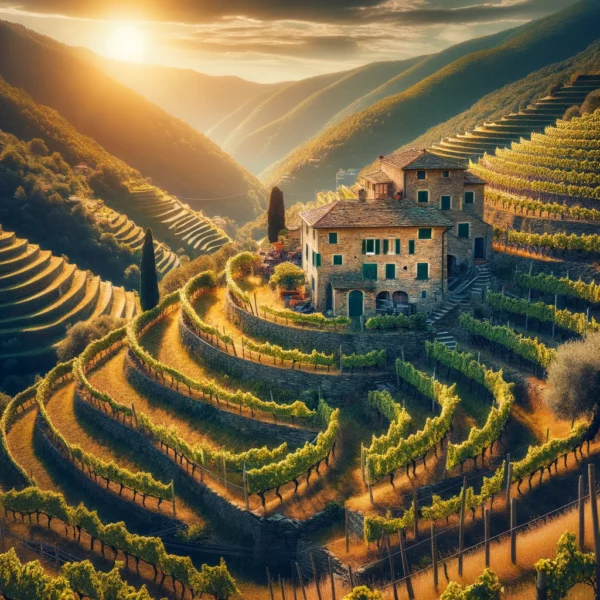
The Uniqueness of Liguria
Liguria’s wines are special and unique for several compelling reasons.
Unique Terroir
Liguria’s distinct geography, nestled between the Mediterranean Sea and the rugged Apennine and Alpine ranges, creates a unique terroir.
This terroir imbues Ligurian wines with a characteristic minerality and freshness that is hard to find elsewhere.
The sea breezes and mountainous terrain contribute to a microclimate ideal for cultivating unique grape varieties.
Indigenous Grape Varieties
Liguria is home to several indigenous grape varieties like Vermentino, Pigato, and Rossese.
These grapes are not widely grown in other regions, making Ligurian wines rare and sought after for their distinctive flavors.
Small-Scale Production with High Quality
Many Ligurian vineyards are small, often family-run operations that focus on quality over quantity.
This artisanal approach ensures meticulous care at every stage of the winemaking process, from vine cultivation to bottling, resulting in exceptional wines.
Historical and Cultural Richness
Liguria has a rich winemaking history that dates back to ancient times.
This history is not just reflected in the vines, but also in the traditional methods still used in many vineyards, offering a taste that is both ancient and timeless.
Diverse Wine Styles
Despite being a small region, Liguria offers a surprising diversity of wine styles, from crisp, aromatic whites like Vermentino to light, fragrant reds like Rossese.
This variety ensures that there’s a Ligurian wine to suit a wide range of palates and occasions.
Food Compatibility
Ligurian wines, with their crisp acidity and nuanced flavors, pair exceptionally well with food, particularly the local cuisine that includes fresh seafood, pesto, and other Mediterranean dishes.
This compatibility makes them a favorite choice for culinary enthusiasts.
Innovative and Sustainable Practices
Many Ligurian winemakers are at the forefront of innovation and sustainability in viticulture, adopting organic and biodynamic practices.
This commitment not only reflects a respect for the land and environment but also ensures the purity and quality of the wine.
In summary, Ligurian wines stand out for their unique combination of terroir, indigenous grapes, quality-driven production, historical richness, diversity, food-friendliness, and sustainable practices.
These factors together create a wine experience that is both distinctive and deeply rooted in the culture and landscape of Liguria.
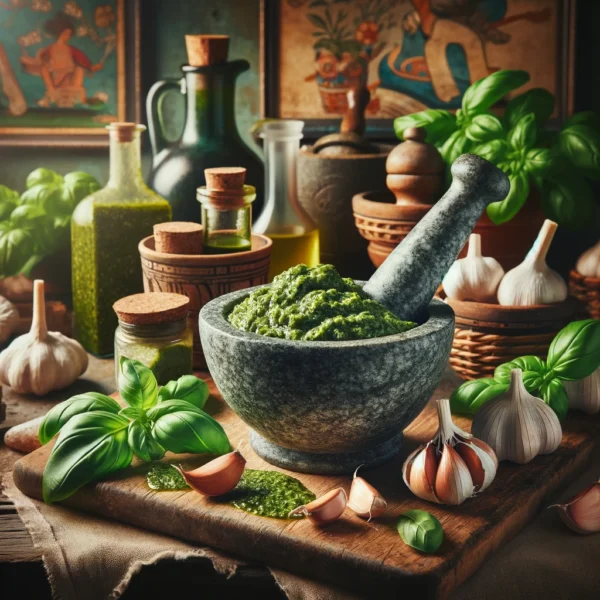
Foods in Liguria
Liguria, with its rich culinary heritage and distinctive wines, offers a delightful array of dishes that pair beautifully with local wines.
Here are some special Ligurian dishes and their perfect wine pairings.
Pesto Genovese
This world-famous basil pesto, made with basil, pine nuts, Parmesan, garlic, and olive oil, is a Ligurian staple.
Pair it with a crisp, refreshing Vermentino, which complements the basil’s freshness and the dish’s rich texture.
Focaccia di Recco
A thin, cheesy version of the classic focaccia, filled with creamy Stracchino cheese.
Enjoy it with a glass of Pigato, whose herbal notes and acidity cut through the richness of the cheese.
Trofie al Pesto
A traditional pasta dish served with Pesto Genovese.
A light and floral Bianchetta Genovese or a Vermentino enhances the flavors of the pesto without overpowering the dish.
Ciuppin
A Ligurian fish stew, similar to bouillabaisse, made with a variety of seafood.
The complexity and richness of the stew pair well with a more structured Vermentino or a light and aromatic Rossese for a red wine option.
Acciughe Ripiene (Stuffed Anchovies)
Anchovies stuffed with a mixture of breadcrumbs, pine nuts, and herbs, often served fried or baked.
A chilled, minerally Pigato or a crisp Vermentino brings out the best in this dish.
Farinata
A thin, crisp pancake made from chickpea flour, often enjoyed as a snack or appetizer.
Pair it with a refreshing, light Rossese or a Sciacchetrà for a sweeter contrast.
Coniglio alla Ligure (Ligurian Rabbit)
Rabbit stewed with olives, pine nuts, and herbs.
This richer dish goes well with a more robust Rossese or a Dolcetto, offering a harmonious balance of flavors.
Sciacchetrà with Desserts
Sciacchetrà, a sweet dessert wine, pairs wonderfully with biscotti or other sweet pastries, creating a delightful end to a Ligurian meal.
These pairings highlight the interplay between Liguria’s diverse culinary flavors and its wine varietals, creating a truly authentic and enjoyable dining experience.
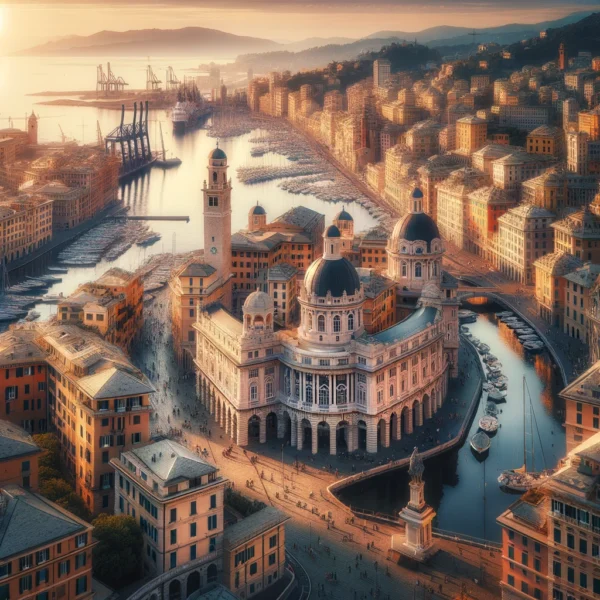
Wine Tourism
For wine enthusiasts, Liguria is a paradise.
Many vineyards offer tours and tastings.
The picturesque landscapes of vineyards nestled between the mountains and the sea make for an unforgettable experience.
Some vineyards also provide local culinary delights, pairing their wines with traditional Ligurian dishes.
Liguria, with its stunning coastline, picturesque villages, and rich cultural history, offers a myriad of special places to see and visit.
Here’s a list of must-visit spots in this charming Italian region.
Cinque Terre
This string of five centuries-old seaside villages on the rugged Italian Riviera coastline is famous for its colorful houses and vineyards clinging to steep terraces.
The villages are linked by walking paths, offering breathtaking views of the sea.
Portofino
A small but chic fishing village, Portofino is known for its picturesque harbor and the pastel-colored houses lining the shore.
It’s a popular destination for shopping, dining, and celebrity sightings.
Genoa (Genova)
The region’s capital city, known for its central role in maritime trade over many centuries.
Genoa has a wealth of art, architecture, and history to explore, including the UNESCO-listed Old Town, with its narrow, winding streets and Renaissance and Baroque palaces.
Sanremo
Famous for its casino and annual music festival, Sanremo is also known for its beautiful beaches, charming old town, and vibrant market.
The Italian Riviera
Stretching from the border with France to the east of Genoa, the Italian Riviera is dotted with beautiful beaches, seaside towns, and hidden coves.
It’s perfect for a leisurely drive or a beach day.
The Hanbury Botanical Gardens
Located near the town of Ventimiglia, these are some of the largest and most diverse botanical gardens in Italy, offering a peaceful escape and stunning sea views.
Levanto
A gateway to the Cinque Terre, known for its sandy beach, surfing, and hiking trails. Levanto has a relaxed vibe and is less crowded compared to the Cinque Terre villages, making it a great place to unwind.
The Gulf of Poets (Golfo dei Poeti)
A bay in the Ligurian Sea near La Spezia, celebrated for its beauty and the inspiration it provided to poets like Lord Byron and Percy Bysshe Shelley.
The area includes charming towns like Lerici and Portovenere.
Camogli
A beautiful, lesser-known fishing village with a lovely harbor, colorful buildings, and a pebbly beach.
It’s perfect for those looking to escape the tourist crowds and enjoy authentic Ligurian charm.
Sestri Levante
Once an island, now a peninsula, Sestri Levante is known for its two bays: Bay of Silence and Bay of Fables, offering picturesque beaches and a charming historic center.
The Royal Palace of Caserta
Although a bit of a journey from Liguria, this 18th-century palace is one of the largest and most opulent palaces in Europe and is well worth a visit if you’re exploring the broader region.
Hiking Trails
For outdoor enthusiasts, Liguria offers numerous hiking trails, including those in the Cinque Terre National Park and the Portofino Natural Park, providing stunning views of the coastline and the Mediterranean landscape.
Each of these places offers a unique glimpse into the beauty and diversity of Liguria, from its breathtaking coastal towns to its rich cultural heritage.
Whether you’re looking for scenic beauty, historical exploration, or just a peaceful retreat by the sea, Liguria has something special to offer every traveler.
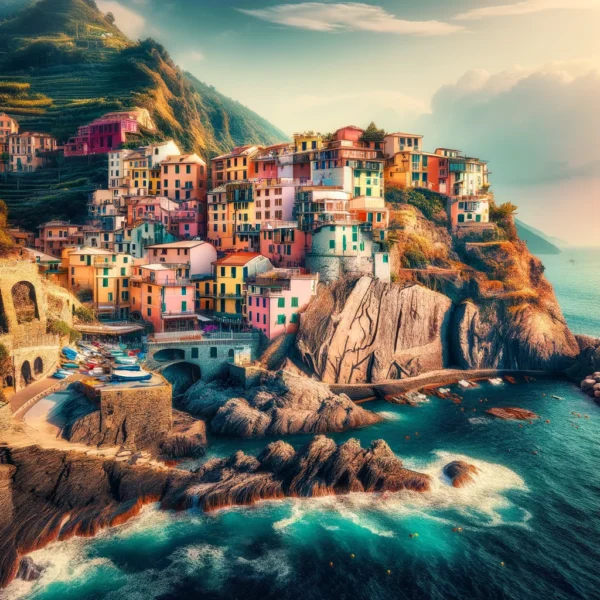
Tips on Visiting Liguria
Visiting Liguria can be a delightful experience, and having some practical tips can make your trip even more enjoyable.
Here are some useful pointers.
Travel Timing
The best time to visit Liguria is either in the late spring (April to June) or early autumn (September to October).
These months offer pleasant weather and fewer crowds compared to the busy summer season.
Accommodation
Book your accommodation in advance, especially if you plan to visit during peak season.
Consider staying in smaller towns or villages for a more authentic experience and often more affordable options than the popular tourist spots.
Getting Around
Liguria is well-served by trains, which are a convenient way to travel between towns, especially along the coast.
Consider getting a regional train pass if you plan to travel frequently.
Renting a car can be useful for exploring more remote areas, but be prepared for narrow, winding roads and limited parking, especially in the Cinque Terre area.
Packing Essentials
Bring comfortable walking shoes as you’ll likely do a lot of walking, especially in hilly areas like the Cinque Terre.
Don’t forget a hat, sunscreen, and sunglasses to protect from the sun, especially in the summer months.
Dining and Wine Tasting
Make reservations for dining in popular restaurants, especially in tourist areas.
Don’t miss out on local Ligurian cuisine and wine tasting at local vineyards.
Beach Visits
If you’re planning to visit beaches, note that many beaches in Liguria are pebbly rather than sandy.
Beach clubs offer facilities like sun loungers and umbrellas, but they can be pricey.
Public beaches are free but may get crowded.
Cultural Etiquette
Italians appreciate politeness.
A simple “buongiorno” (good morning) or “buonasera” (good evening) goes a long way.
Also, remember to dress modestly when visiting churches or religious sites.
Stay Hydrated
Keep a reusable water bottle with you.
You’ll find public water fountains in many towns where you can refill your bottle.
Cash and Cards
While credit cards are widely accepted in most places, it’s a good idea to carry some cash, especially for small purchases in local markets or in smaller towns.
Language
Knowing a few key Italian phrases can enhance your experience.
While many people in tourist areas speak English, locals will appreciate your efforts to speak their language.
Hiking Preparedness
If you plan to hike, especially in the Cinque Terre, ensure you have appropriate gear.
Check trail conditions in advance as some trails may be closed due to weather or maintenance.
Respect the Environment
Liguria is known for its natural beauty.
Always be mindful of the environment by not littering and respecting wildlife and natural habitats.
Local Markets and Shops
Explore local markets and shops for unique souvenirs and gifts.
Liguria is known for its olive oil, pesto, and ceramics.
Mobile Connectivity
Consider getting a local SIM card for your mobile phone for better connectivity and to avoid roaming charges.
Emergency Numbers
Know the local emergency numbers. In Italy, 112 is the general emergency number.
By keeping these tips in mind, you’ll be well-prepared to enjoy all that Liguria has to offer, from its stunning coastal views and charming villages to its delicious cuisine and wines.
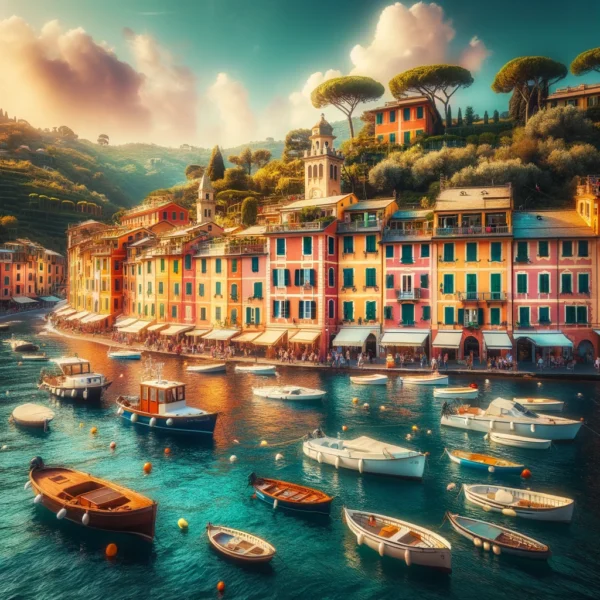
Wine Purchasing
Ligurian wines, though not as globally famous as those from Tuscany or Piedmont, are hidden gems for wine lovers.
For those looking to purchase, explore local wine shops or online retailers specializing in Italian wines.
Best vintages of Liguria
Determining the “best” vintages in Liguria, as with any wine region, can be somewhat subjective and varies depending on the type of wine.
However, certain years stand out due to favorable climatic conditions that result in exceptional quality wines.
Here are some general guidelines to consider.
Vermentino and Pigato
These white grapes benefit from years with a balanced climate – not too hot, with adequate rainfall and enough sunshine to ripen the grapes while maintaining their acidity.
Look for years where the weather reports indicate such conditions.
Rossese and Other Reds
For reds like Rossese, warmer and drier years can be more favorable as they allow the grapes to ripen fully, developing richer flavors.
However, excessive heat can be detrimental, so it’s a delicate balance.
Recent Trends
In recent decades, due to changes in climate and advancements in viticulture and winemaking techniques, many regions, including Liguria, have seen a general increase in the quality of their wines.
This means that more recent vintages may be more consistently reliable in quality.
Vintage Variability
It’s important to note that Liguria, with its diverse microclimates and varied terrain, can experience significant vintage variability.
This means that the quality of wines can vary from one area to another within the same vintage year.
Personal Preference
Ultimately, the “best” vintage can also depend on personal taste.
Some wine enthusiasts might prefer the freshness and acidity of younger wines, while others might appreciate the complexity and depth of flavors in older vintages.
Visiting Local Wineries
If you have the opportunity to visit Liguria, tasting wines at local wineries can be an excellent way to discover which vintages resonate most with your palate.
Winemakers and local experts can provide valuable insights into the characteristics of different vintages.
In summary, the best vintages in Liguria depend on the type of wine, weather conditions of the year, advancements in wine-making, and personal preferences.
Recent years have generally seen a high quality of production, but exploring different vintages and consulting expert opinions can lead to discovering exceptional wines that capture the unique essence of Liguria’s terroir.
In summary, Liguria offers a delightful and diverse wine experience.
Its unique geographical location, combined with a rich cultural heritage, results in wines that are not only distinctive but also reflect the heart and soul of the region.
Whether you’re a wine aficionado or a curious explorer, Liguria’s vineyards and their offerings are sure to captivate and enchant.

FAQs:
Q1: What types of wines is Liguria known for?
A1: Liguria is primarily known for its white wines, such as Vermentino and Pigato, which are celebrated for their crisp, floral, and citrusy notes.
The region also produces notable red wines like Rossese, known for being light, aromatic, and fruity.
Q2: Can you visit vineyards in Liguria?
A2: Yes, many vineyards in Liguria offer tours and tastings.
The region’s picturesque landscapes make it an ideal destination for wine tourism, offering a combination of scenic beauty and unique wine experiences.
Q3: How does Liguria’s geography influence its wines?
A3: Liguria’s unique geography, with steep terrains close to the sea, creates microclimates that are ideal for viticulture.
This geography contributes to the distinct mineral and floral characteristics found in Ligurian wines.
Q4: What are some of the notable vineyards in Liguria?
A4: Notable vineyards include Cantine Lunae Bosoni, Poggio dei Gorleri, and vineyards in the Cinque Terre region.
Each vineyard has its unique story and contributes significantly to the region’s wine heritage.
Q5: Is Liguria more famous for its red or white wines?
A5: Liguria is more renowned for its white wines, especially Vermentino and Pigato.
However, its red wines, particularly Rossese, are also gaining recognition for their quality and unique characteristics.
Q6: What makes Ligurian wines unique compared to other Italian wines?
A6: Ligurian wines stand out due to their unique terroir influenced by the region’s coastal location, steep terrains, and distinct microclimates.
This results in wines with a notable minerality and freshness, different from other Italian wine regions.
Q7: Are there any indigenous grape varieties in Liguria?
A7: Yes, Liguria is home to indigenous grape varieties such as Pigato and Rossese, which are not commonly found outside the region.
Q8: What is the best time of year to visit Ligurian vineyards?
A8: The best time to visit is late spring through early fall, when the weather is pleasant, and the vineyards are at their most scenic.
Harvest season in early autumn is particularly special, offering a chance to see the winemaking process in action.
Q9: Can Ligurian wines be easily found outside Italy?
A9: While not as widely exported as some other Italian wines, Ligurian wines are increasingly available in international markets, especially in specialty wine stores and Italian restaurants.
Q10: Are there any wine festivals or events in Liguria?
A10: Yes, Liguria hosts various wine festivals and events throughout the year, celebrating its wine culture and offering opportunities to taste and learn about local wines.
These events are fantastic for experiencing Ligurian wines and traditions firsthand.

Experience Wine Like Never Before with Coravin!
🍷 Introducing the Coravin Model Limited Edition Wine Preservation System in Steel Blue 🍷
🌟 Savor Every Drop: Why settle for just one bottle? With Coravin, enjoy any wine, any time, without ever pulling the cork. Your wine collection, unlocked with unparalleled freedom.
💎 Elegant Design, Superior Quality: Crafted in stunning Steel Blue and made with durable stainless steel, this isn’t just a wine tool; it’s a centerpiece that speaks to your sophisticated taste.
🚀 State-of-the-Art Technology: Featuring a Teflon coated wine needle, pour your wine smoothly and effortlessly, preserving every cork and every flavor.
🌬️ Ultimate Preservation: Each Coravin capsule uses ultra-pure argon gas to protect your wine from oxidation. Your last glass will be just as perfect as your first, even years later.
🎉 Perfect for Every Occasion: Whether you’re hosting a party or enjoying a quiet evening, Coravin ensures your favorite wine is always on the menu.
💡 Easy and Convenient: Celebrated for its ease of use and light weight, make every pour a joyous experience.
💸 A Wise Investment: Praised for its value for money, Coravin is not just a luxury; it’s an essential for every wine lover.
🌐 Ready for the World: Designed for US outlets but adaptable globally, your Coravin experience knows no bounds.
👉 Get Yours Today! Elevate your wine experience with Coravin. 🍇✨




